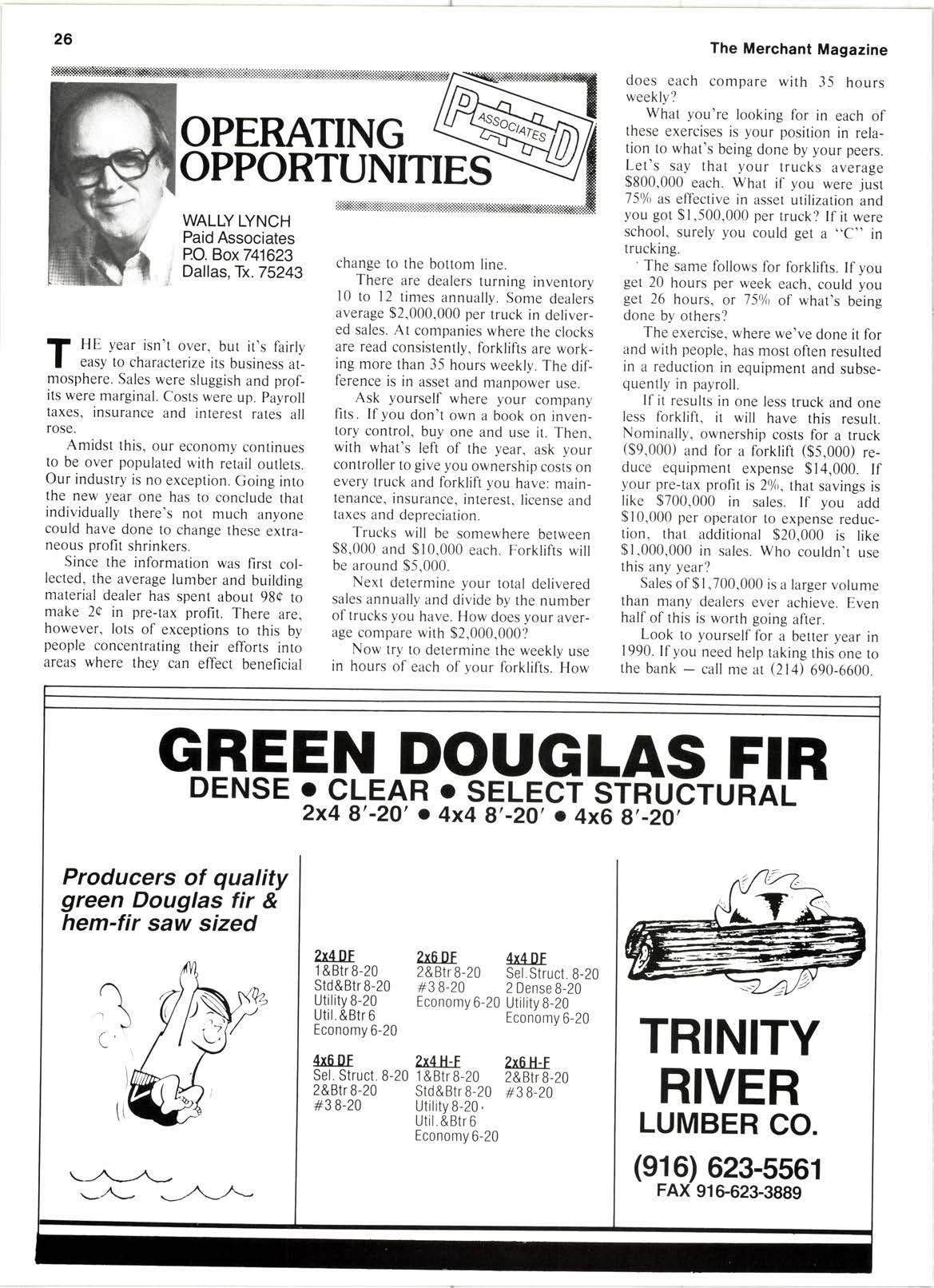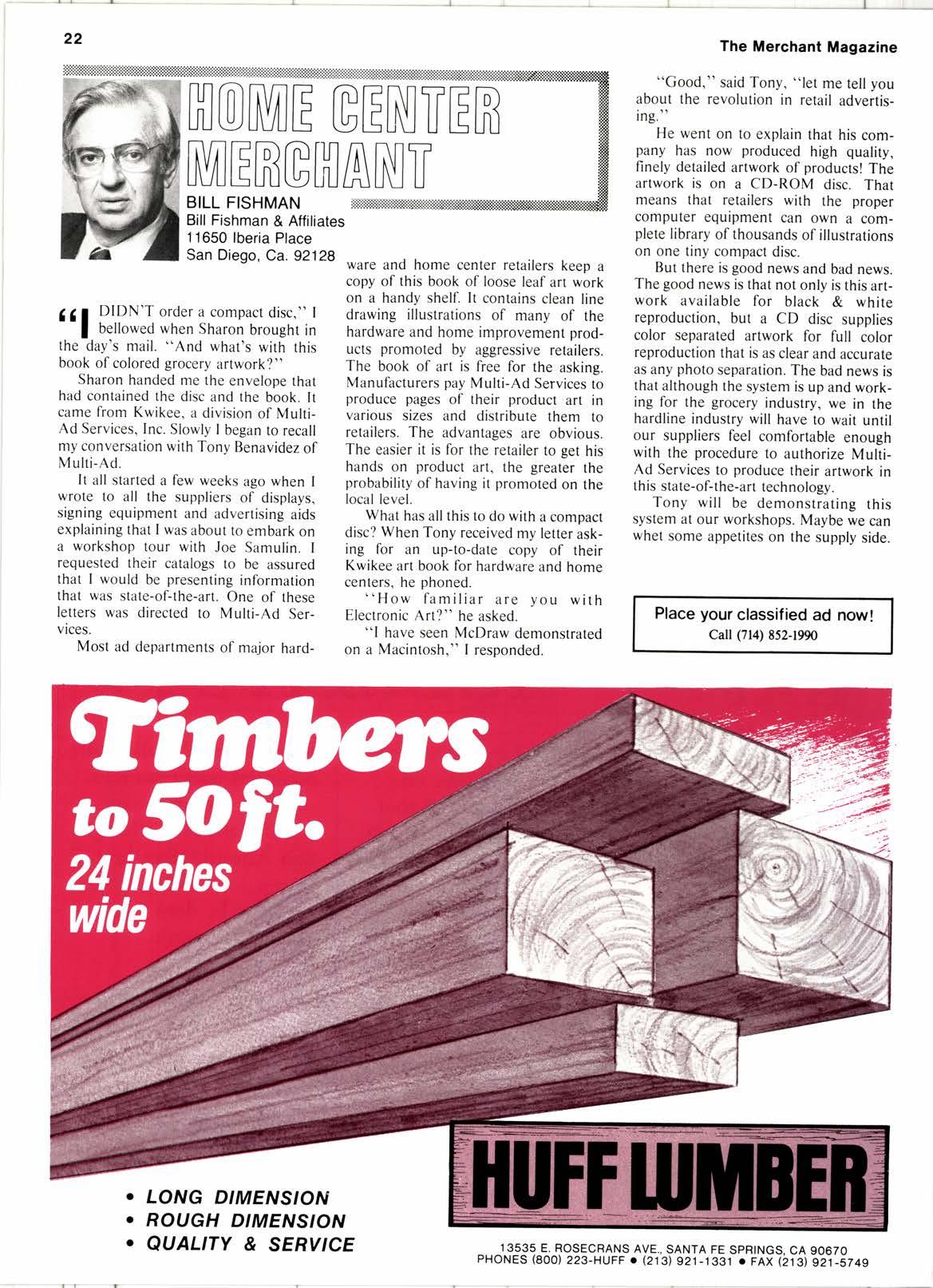
8 minute read
HOME GENTER MERGTTANT
BILL FISHMAN
Bill Fishman & Affiliates
11650 lberia Place
San Diego, Ca.92128
661 DIDN'T order a compacr disc." I I bellowed when Sharon brought in the day's mail. "And what's with this book of colored grocery artwork?"
Sharon handed me the envelope that had contained the disc and the book. It came from Kwikee, a division of MultiAd Services, Inc. Slowly I began to recall my conversation with Tony Benavidez of Multi-Ad.
It all started a few weeks ago when I wrote to all the suppliers of displays, signing equipment and advertising aids explaining that I was about to embark on a workshop tour with Joe Samulin. I requested their catalogs to be assured that I would be presenting information that was state-of-the-art. One of these letters was directed to Multi-Ad Services.
Most ad departments of major hard- ware and home center retailers keep a copy of this book of loose leaf art work on a handy shelf. lt contains clean line drawing illustrations of many of the hardware and home improvement products promoted by aggressive retailers. The book of art is free for the asking. Manufacturers pay Multi-Ad Services to produce pages of their product art in various sizes and distribute them to retailers. The advantages are obvious. The easier it is for the retailer to get his hands on product art, the greater the probability of having it promoted on the local level.
What has all this to do with a compact disc? When Tony received my letter asking for an up-to-date copy of their Kwikee art book for hardware and home centers, he phoned.
"How familiar areyou with Electronic Art?" he asked.
"l have seen McDraw demonstrated on a Macintosh," I responded.
"Good," said Tony, "let me tell you about the revolution in retail advertising."
He went on to explain that his company has now produced high quality, finely detailed artwork of, products! The artwork is on a CD-ROM disc. That means that retailers with the proper computer equipment can own a complete library of thousands of illustrations on one tiny compact disc.
But there is good news and bad news. The good news is that not only is this artwork available for black & white reproduction, but a CD disc supplies color separated artwork for full color reproduction that is as clear and accurate as any photo separation. The bad news is that although the system is up and working for the grocery industry, we in the hardline industry will have to wait until our suppliers feel comfortable enough with the procedure to authorize MultiAd Services to produce their artwork in this state-of-the-art technology.
Tony will be demonstrating this system at our workshops. Maybe we can whet some appetites on the supply side.
Place your classified ad now! Call (714) 852-1990
r{;EfufuV DilR1"STT"IAE NEln VFAR- ! r{APFV
Tt gLves rrs grunt p[zwsurv tn wLsh Vou ttw bzst' fot tfw hoLidny svwsotu wnd, thv tww Veclr. l{'vre a.t La,rwr,,wwtzil, TLrwber ws bsLle,ve Ln wLL tttv oLd,-JwshLoneil, vwLuvs honsstLJ, fLne servLcv, r @spotusLvenoss, cowsid.sr wtinw, wnd, f wwtwss .
1,t's w joV tD work wnil, il,Lscovux thwt we wLL ?Lwve a. chwwcv to grow. Perhwps wv a.ppreci,wtz the " gooil, LLJz" ftLore wnil, ftJ.or@, DS we rewd, the tr.vwspclpers, At, wfrV rwtv, Lt is grvwt to LLvv Lw Arwertcw, enjoy f reeil,otw, wnil, k now th.wt our fwrru.[,,ws wre hwvLng ttls br,ggest, opportunLtLvs Lw t[w wor[.d,,.
T?w l-wrwi,nntgd, TLrwbvr tpatw wa.nts tn shwre t*wsv oLd,-fa.shLonp-d, vaLuss wLth Vou wwil, tn wtsh Vow good, hvwLth wwil, prospu.,rLty fot thv Nvw l)ewr 1990.
17O5 Sor*th frow Vi,ew, Sfu. 606, Owtn'rin, CA" gI76I
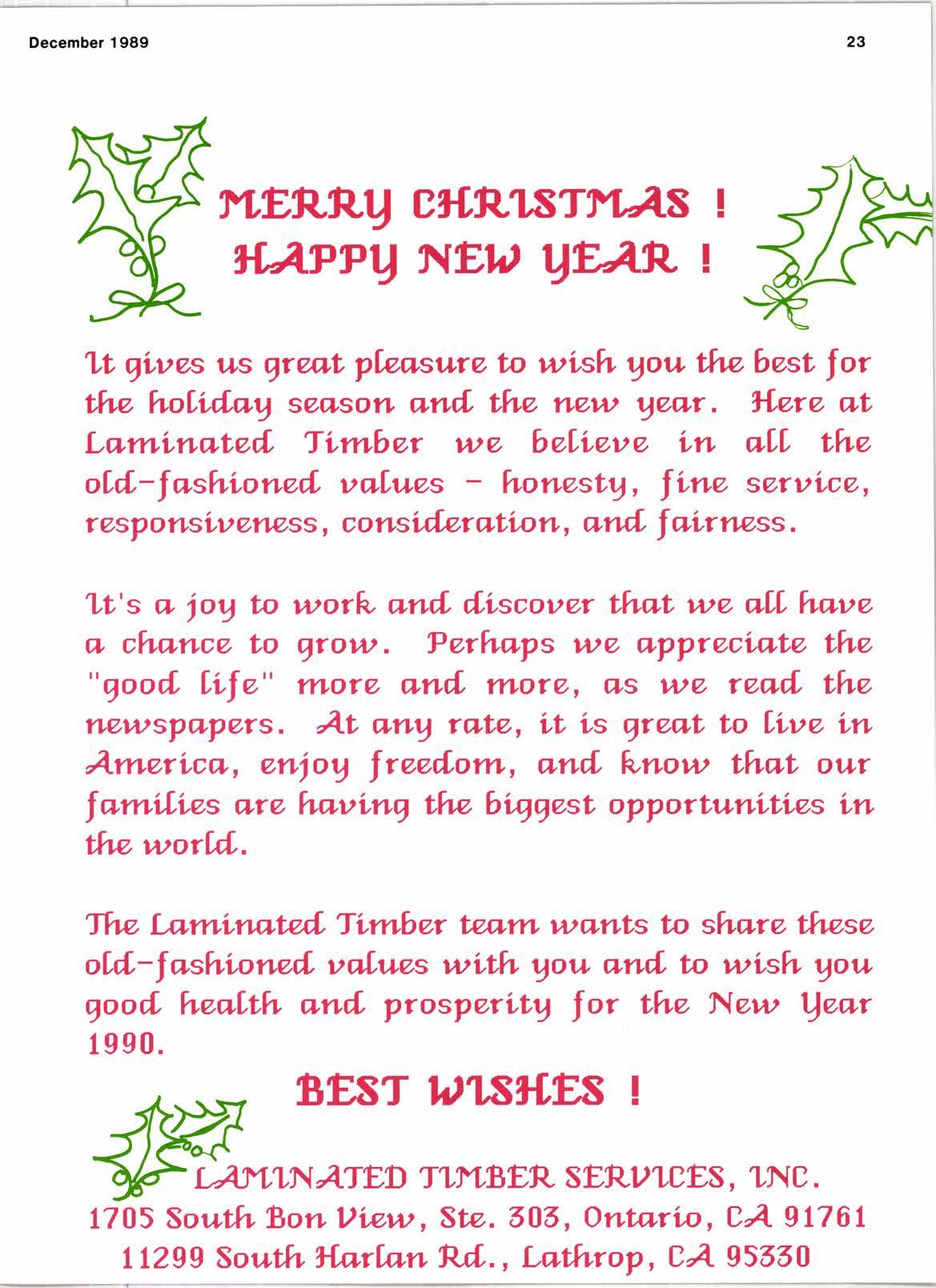
WAYN f
GARDNER executive vice
Ll OW MANY times have we said to fl one of our children, "that's not what I expected," after we saw or heard the results of his actions? Or an item ordered from a catalog was received and our feeling was "that's not what I expected." Or we ordered an entree in a restaurant and when it arrived and was tasted, our response was "that's not what I expected."
With our children, some act or words of theirs may meet with disapproval. What they did was not what we wanted them to do. We perceived their actions or statements as reflecting badly on us, the parents.
On items we ordered, maybe they were oversold, described in words which painted a different picture than actually was the case. In the restaurant. mavbe the waiter told us about an entree he thought outstanding, but it wasn't, to our way of thinking.
With our children, is it possible that they are acting like we may have acted, rather than how we told them to act? Without thinking, maybe we set a bad example for them. So, what do we expect?
In the restaurant or with a mail order item or in dealing with people, we seem to have expectations that frequently are not met.
Could it be that all the talking is one way? Are we giving our children a chance to ask questions about what we have told them? Are we giving employees a chance to ask questions about a task, company policy or the myriad of things affecting the employee? Customer policy, hiring policy, return policy, items that affect the bottom line. Are we communicating realistically?
When something goes wrong, our in- clination is to say "that's not what I wanted." In the case of people, maybe it's because we have not given them an opportunity to ask questions. We have not communicated. We talk and someone listens. But do they? We have to be informative. We have to be in communication with others. We have to think about what we are saying. We have to think of our statements in the context of the receiver. We have to state our desires in terms he will understand. ln the lumber industry, we deal manv times not with the ultimare .onri,r.i, but with an intermediary. Grading rules were developed so that we could communicate between segments of the industry as well as the consumer.
In dealing with intermediaries, we need to talk about grades and we need to encourage the buyer to ask questions. We need to ask questions when we buy and sell. Only in this way will misunderstanding be minimized.
In any situations we want to expect the best. The only way to get the best is to expect the best. Put lorth your best effort and communicate (talk, listen and ask questions).
Then the question "what did you expect?" will give you the answer you expect. Only the best.
Fremont specializes in a large inventory of high qualrtyDouglas6rboards.dimension,longlengths tantly adding to our selection oF western red cedar, pine, hemlock and white fir. Other species and specialty items are inventoried and included in our weekly flyer sent to all Fremont customers.
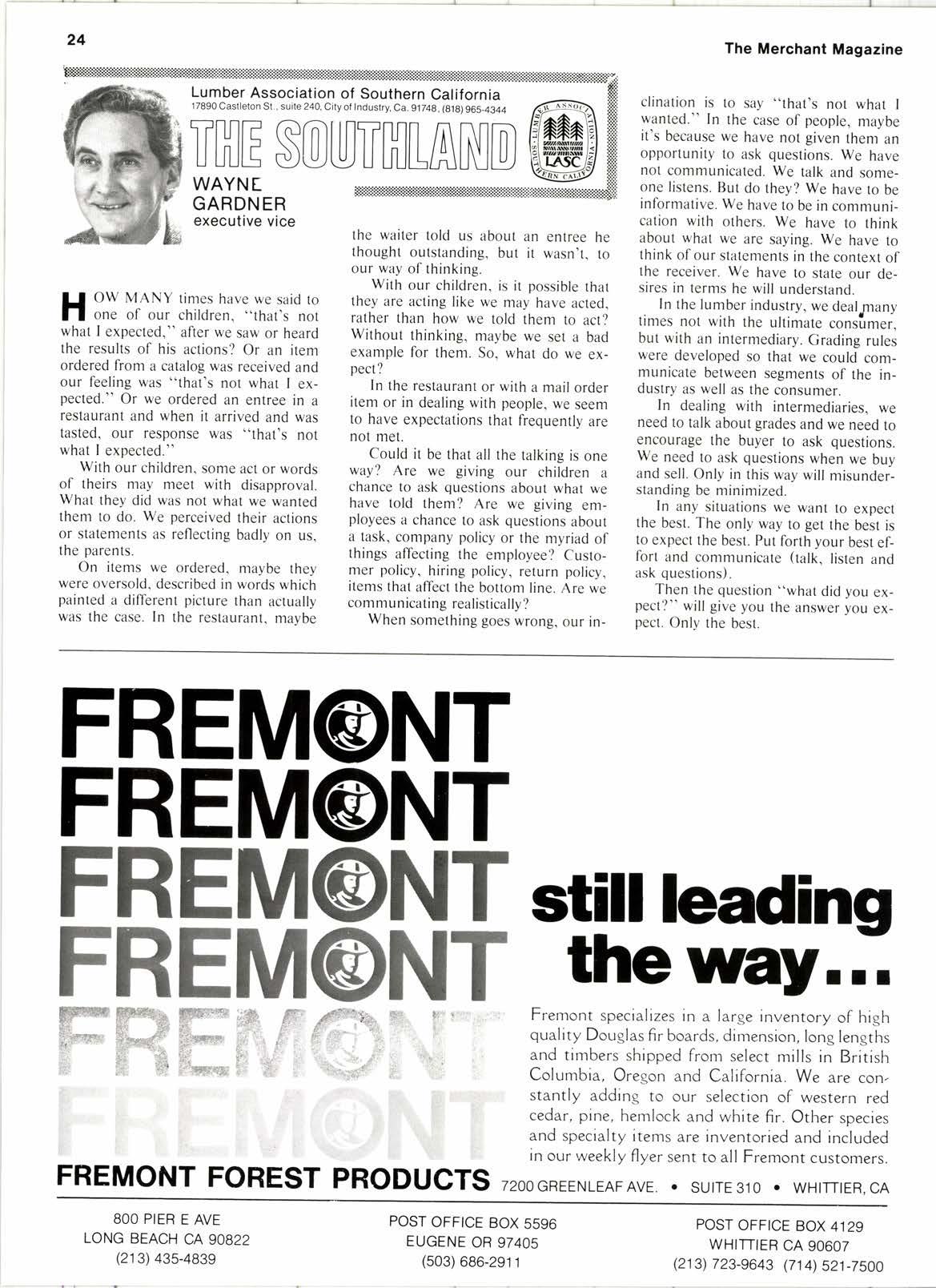
CHUCK LINK executive director
I IOST successful closely held busilUl nesses were built with an eye on the bottom line.
The tax enemy was the income tax. Little or no thoudht was given to transferring the business to the children or how much the transfer would cost the family in estate tax. Well, the IRS has been thinking about it, and tax reform has given the IRS some new weapons.
The new law is designed to Prevent you from freezing the value ofyour business for estate tax purposes. Recapitalization (where you hold preferred stock, and future growth, which is in the common stock, is transferred to the kids) are outlawed by tax reform. For most business owners, this means getting the transferjob done by going back to basicssale or gift of stock to the children.
A sale of all or a portion of the stock of a profitable family business to the children is an effective way of removing future growth from the seller's (assume father's) estate. But there is a price to pay. Father must pay tax on the capital gain and the children need income to make nondeductible payments to father.
A smart tax maneuver is to have the children make an election to operate as an S corporation as soon as the stock is purchased. This gives the children the business' profits as a cash-flow source to pay for the purchased stock. In addition' the interest paid by the children becomes fully deductible because they are purchasing the stock of an S corporation.
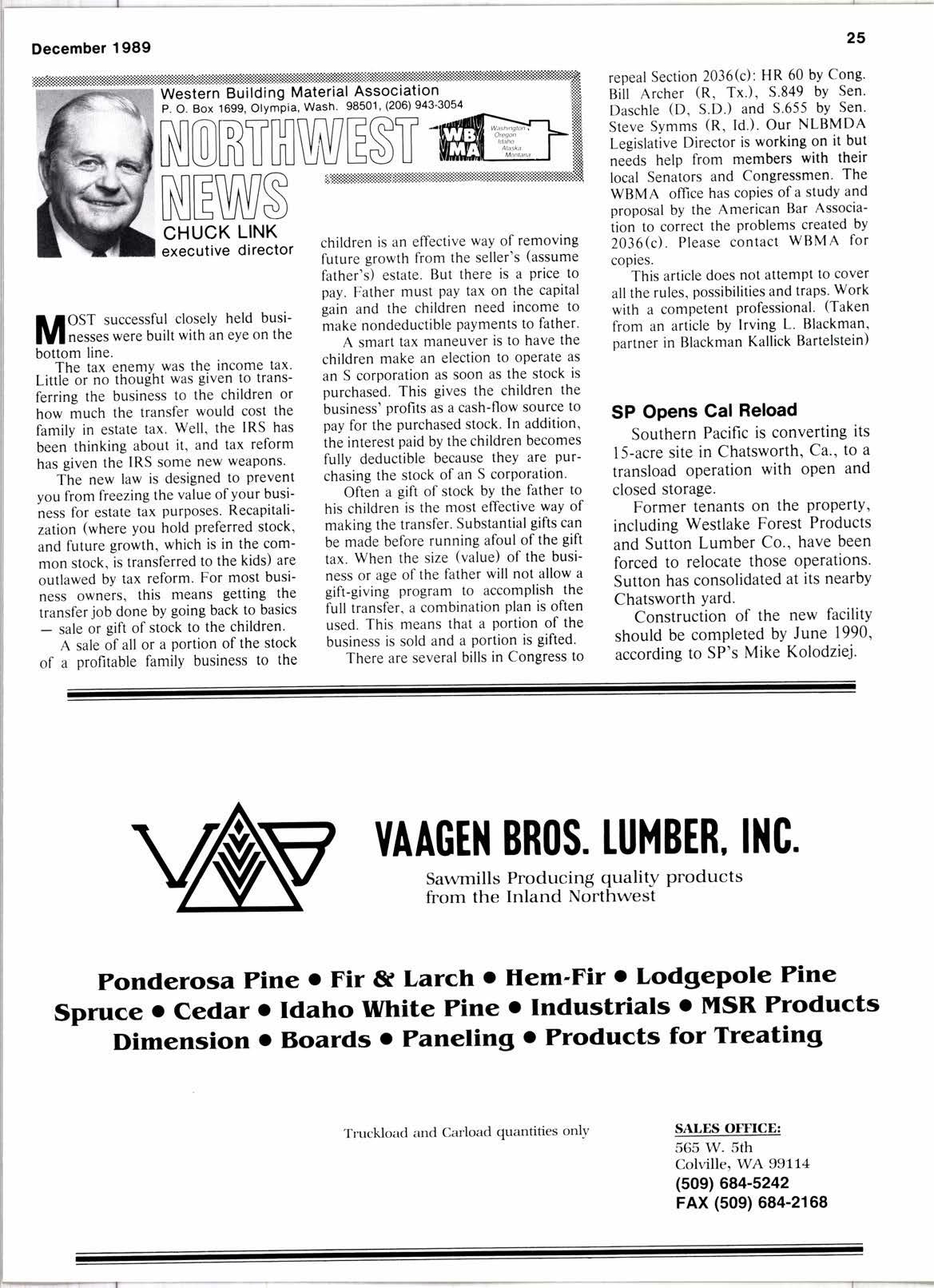
Often a gift of stock by the father to his children is the most effective way of making the transfer. Substantial gifts can be made before running afoul of the gift tax. When the size (value) of the business or age of the father will not allow a gift-giving program to accomplish the full transfer, a combination plan is often used. This means that a portion of the business is sold and a portion is gifted.
There are several bills in Congress to reoeal Section 2036(c): HR 60 bv Cong. Biil Archer (R, Tx.), S.849 bY Sen. Daschle (D, S.D.) and 5.655 bY Sen' Steve Symms (R, Id.). Our NLBMDA Legislative Director is working on it but needs help from members with their local Senators and Congressmen' The WBMA office has copies of a studY and proposal by the American Bar Association to correct the problems created by 2036(c). Please contact WBMA for copies.
This article does not attempt to cover all the rules, possibilities and traps. Work with a competent professional. (Taken from an article by lrving L. Blackman' partner in Blackman Kallick Bartelstein)
SP Opens Cal Reload
Southern Pacific is converting its 15-acre site in Chatsworth, Ca., to a transload operation with oPen and closed storage.
Former tenants on the Property, including Westlake Forest Products and Sutton Lumber Co., have been forced to relocate those operattons. Sutton has consolidated at its nearby Chatsworth Yard.
Construction of the new facilitY should be comPleted bY June 1990, according to SP's Mike Kolodziej.
WALLY LYNCH Paid Associates PO. Box 741623 Dallas,Ix.75243
HE year isn't over, but it's fairly easy to characterize its business atmosphere. Sales were sluggish and profits were marginal. Costs were up. payroll taxes, insurance and interest rates all rose.
Amidst this, our economy continues to be over populated with retail outlets. Our industry is no exception. Going into the new year one has to conclude that individually there's not much anyone could have done to change these extraneous profit shrinkers.
Since the information was first collected, the average lumber and building material dealer has spent about 980 to make 20 in pre-tax profit. There are, however, lots of exceptions to this by people concentrating their efforts into areas where they can effect beneficial change to the bottom line.
There are dealers turning inventory 10 to l2 times annually. Some dealers average $2,000,000 per truck in delivered sales. At companies where the clocks are read consistently, forklifts are working more than 35 hours weekly. The difference is in asset and manpower use.
Ask yourself where your company fits. Ifyou don't own a book on inventory control, buy one and use it. Then. with what's left of the year, ask your controller to give you ownership costs on every truck and lorklift you have: maintenance, insurance, interest, license and taxes and depreciation.
Trucks will be somewhere between $8,000 and $10,000 each. Forklifts will be around $5.000.
Next determine your total delivered sales annually and divide by the number oftrucks you have. How does your average compare with $2,000,000?
Now try to determine the weekly use in hours of each of your forklifts. How does each compare with 35 hours weekly?
What you're looking for in each of these exercises is your position in relation to what's being done by your peers. Let's say that your trucks average $800,000 each. What if you were just 750h as effective in asset utilization and you got $1,500,000 per truck? If ir were school, surely you could get a "C" in trucking.
' The same follows for forklifts. lf you get 20 hours per week each, could you get 26 hours, or 750/o of what's being done by others?
The exercise, where we've done it for and with people, has most often resulted in a reduction in equipment and subsequently in payroll.
If it results in one less truck and one less forklift, it will have this result. Nominally, ownership costs for a truck ($9,000) and for a forktift ($5,000) reduce equipment expense $14,000. If your pre-tax profit is 20h, rhat savings is like $700,000 in sales. If you add $10,000 per operator to expense reduction, that additional $20,000 is like $1,000,000 in sales. Who couldn't use this any year?
Sales of $1,700,000 is a larger volume than many dealers ever achieve. Even half of this is worth going after.
Look to yourself for a better year in 1990. Ifyou need help raking this one to the bank - call me ar (214) 690-6600.
